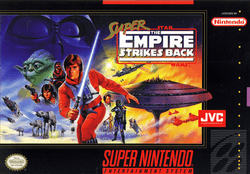Super Star Wars: The Empire Strikes Back
| Super Star Wars: The Empire Strikes Back | |
|---|---|
 Cover art | |
| Developer(s) |
Sculptured Software LucasArts |
| Publisher(s) |
JVC, later re-released by THQ (SNES) LucasArts (Virtual Console) |
| Director(s) | Kalani Streicher |
| Producer(s) | Kalani Streicher |
| Designer(s) | Kalani Streicher |
| Programmer(s) |
Peter Ward Ryan Ridges |
| Composer(s) | Paul Webb[1] |
| Platform(s) | Super NES |
| Release date(s) |
Super NES
Virtual Console |
| Genre(s) | Run and gun |
| Mode(s) | Single player |
Super Star Wars: The Empire Strikes Back, also known as Super Empire Strikes Back, is a 1993 run and gun game for the Super Nintendo Entertainment System. It is the second game in the Super Star Wars trilogy and is based on the 1980 film The Empire Strikes Back. It was released in Japan by Victor Interactive Software as Super Star Wars: Teikoku no Gyakushuu. The original Super NES game was released on 1993. The game was followed by a sequel based on the next film in the Star Wars series, Super Star Wars: Return of the Jedi. Super Star Wars: The Empire Strikes Back was re-released on the Virtual Console in North America on August 24, 2009[2] and in the PAL regions on October 2, 2009, alongside the other games in the Super Star Wars series.
Gameplay
Super Star Wars: The Empire Strikes Back follows closely the standard set by its predecessor, with multiple playable characters and Mode 7 quasi-3D vehicle sequences. The controls are very similar to the first game, but feature a double-jump. Luke Skywalker, Han Solo, and Chewbacca return as playable characters although the character-select option itself was removed.
Unlike the original game, this installment allows each character the use of a primary and secondary weapon. Following one of the Dagobah missions, Luke Skywalker can also collect Force Powers for use in later levels. Luke can now block incoming attacks using his lightsaber, allowing him to deflect blaster fire. Han Solo can now throw grenades and Chewbacca has a new power up: a spinning attack. Darth Vader appears as the final boss in the video game.
Development
The previous game in the series was known for its high level of difficulty which was continued in the sequel. In response to this concern, a password system was introduced to allow players to proceed from the level in which their game ended and not have to start back at the beginning of the game when they were out of continues.[3] An "asteroid chase" stage using Mode 7 effects was cut from the game due to lack of cartridge space.[4] In late 1992 a contest was launched exclusively in Electronic Gaming Monthly,[5] which required the contestants to answer six multi-choice questions, and for which the "Grand Prize" was to have the person's likeness appear in this forthcoming game. The winner was Jeff Crosno, for whom the developers placed his appearance on a Rebel soldier in an Ice Fields of Hoth cut-scene, replacing the already existing facial graphics.[6]
Reception
The game was met with highly positive reviews. IGN praised the games enhanced "Mode 7" graphics.
References
- ↑ "Composer information for Super Star Wars: The Empire Strikes Back". SNES Music. Retrieved 2012-07-05.
- 1 2 "Jedi Battles, Marvelous Bubbles and Frantic Underground Action". Nintendo of America. 2009-08-24. Retrieved 2009-12-14.
- ↑ IGN Cheats: Super Empire Strikes Back
- ↑ "The GameMakers: The Artists". GamePro. IDG (85): 36–38. October 1995.
- ↑ Electronic Gaming Monthly, December 1992, page 142, "JVC, LucasArts & EGM Want You!"
- ↑ Electronic Gaming Monthly, October 1993, Issue 51, page 216. "EGM Contest Winner Update" A picture of 'Jeff Crosno' is seen with two screenshots from the game. The before and after images of the character's facial changes.
External links
- Super Star Wars: The Empire Strikes Back at the Internet Movie Database
- Super Star Wars: The Empire Strikes Back at MobyGames